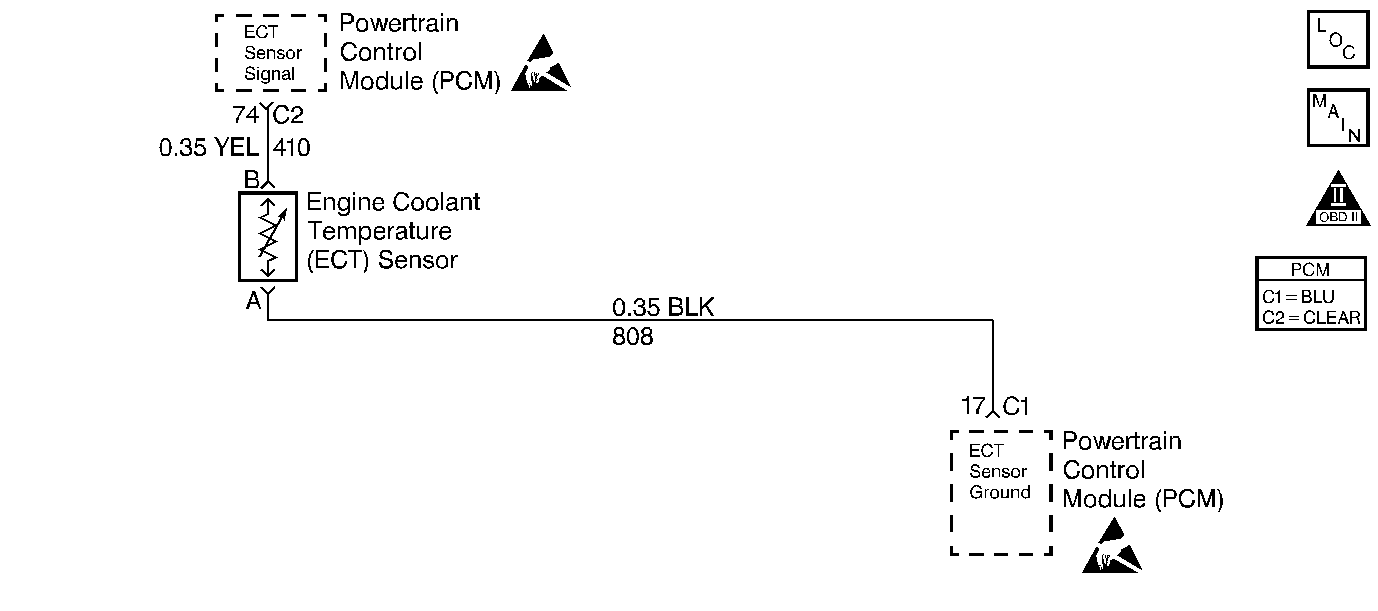
Circuit Description
The Engine Coolant Temperature sensor circuit uses two pull-up resistors for temperature sensing. When sensor resistance is high indicating low temperatures the PCM uses a 3.65K ohms resistor and a 348 ohms resistor in series. As temperature increases to 50°C (122°F), the sensor resistance will decrease to 973 ohms. This resistance corresponds to 0.97 volt at the PCM. At this point the PCM shifts to the single 348 ohms pull-up resistor to measure temperature above 50°C (122°F). The PCM monitors the voltage signal of the circuit and assumes that engine operation causes coolant temperatures to change at slow rates. This diagnostic test monitors the engine coolant temperature sensor voltage. If the PCM detects a large change in sensor output voltage in a 1 second period, DTC P0116 will set.
Conditions for Setting the DTC
Test Conditions
| • | At least 2 seconds have passed since key ON. |
| • | At least 2 seconds have passed since PCM has commanded a shift in engine coolant temperature pull-up resistors.This occurs when sensor resistance indicates 50°C (122°F). |
Failure Condition
Engine coolant temperature sensor voltage has changed 0.3 volts or more in one second.
Action Taken When the DTC Sets
| • | The Malfunction Indicator Lamp (MIL) will not illuminate. |
| • | No message will be displayed. |
Conditions for Clearing the DTC
| • | A History DTC will clear after forty consecutive warm-up cycles with no failures of any non-emission related diagnostic test. |
| • | A Last Test Failed (current) DTC will clear when the diagnostic runs and does not fail. |
| • | Use a scan tool to clear DTCs. |
| • | Interrupting PCM battery voltage may or may not clear DTCs. This practice is not recommended. Refer to Clearing Diagnostic Trouble Codes in PCM Description and Operation. |
Diagnostic Aids
If fault is not present perform Powertrain Ground Check and also review Failure Rec. to determine conditions under which and how long ago the DTC set.
Test Description
Number(s) below refer to the step number(s) on the Diagnostic Table.
-
Checking DTC P0116 snapshot value to determine if an intermittent high resistance caused the DTC to set.
-
An intermittent high resistance can be caused by an open in the ECT sensor signal circuit or the ECT sensor ground circuit.
-
An intermittent low resistance can be caused by a short to ground on the ECT sensor signal circuit.
-
Checking the ECT sensor's ability to read a full range of temperatures.
Step | Action | Value(s) | Yes | No |
|---|---|---|---|---|
1 | Was the Powertrain On-Board Diagnostic (OBD) System Check performed? | -- | Go to A Powertrain On Board Diagnostic (OBD) System Check | |
2 | Are DTCs P0117 or P0118 set? | -- | Go to DTCs that are set | |
Is snapshot ECT sensor reading less than the value specified? | -37°C (-35°F) | |||
Was an open condition repaired? | -- | Go to Powertrain Control Module Diagnosis for Verify Repair | ||
5 | Is snapshot ECT sensor reading more then the value specified? | 147°C (247°F) | ||
Was a shorted to ground condition repaired? | -- | Go to Powertrain Control Module Diagnosis for Verify Repair | ||
Was a skip or jump noted? | 35°C (95°F) | Fault not present. Refer to Diagnostic Aids | ||
8 | Replace the ECT sensor. Refer to Engine Coolant Temperature (ECT) Sensor Replacement . Is the replacement complete? | -- | Go to Powertrain Control Module Diagnosis for Verify Repair | -- |
